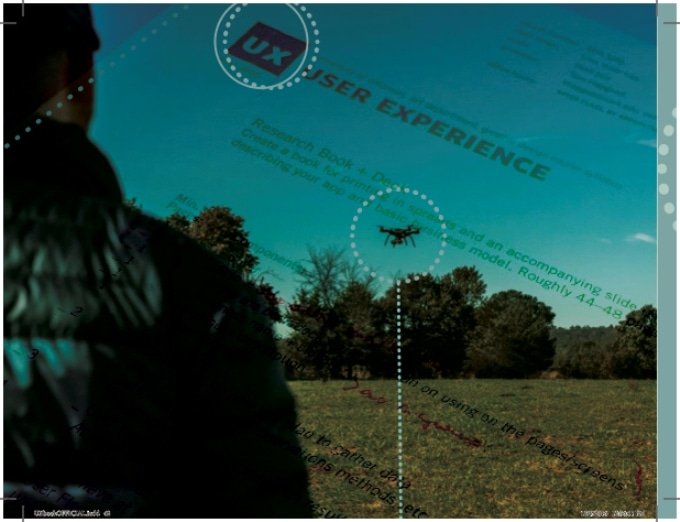Jul 10 2017
Drones are being used in an increasingly diverse number of ways, from delivering packages to assessing crop yields.
 User interface created by Emily Winter in Tom Hapgood's user experience class. (Credit: University of Arkansas)
User interface created by Emily Winter in Tom Hapgood's user experience class. (Credit: University of Arkansas)
So why not use them as part of an app that allows users to pluck garbage from a lake? Pollinate flowers? Retrieve lost or stolen goods?
These are just some of the ideas that were developed by graphic design students in Tom Hapgood's user experience class in the J. William Fulbright College of Arts and Sciences and its Department of Art last fall.
Students teamed up to start conceptual companies, research potential customers and create visualization books to pitch their ideas. The goal was to understand the importance of user needs in design, said Hapgood, professor in the department's graphic design program, which now offers a Bachelor of Fine Arts in graphic design.
"Who is the user and how can we help them use the app more effectively?" Hapgood asked. "The major learning outcome for the class was to ensure that design students understand the user before they design something, that they design what the user needs, versus designing what they think the user needs."
Students didn't completely design and program the apps - a process beyond the scope of the class - but took the project from data gathering through information design. Informal surveys helped them create composite types of consumers they translated into user personas.
Students developed their mock technologies with user flow in mind, creating prototype sketches and digital wireframes and prototypes. The students did their best to understand how a user of the app would best tap through a series of screens to accomplish a goal, for example.
Their ideas included a swarm of tiny drones used to assist bees in pollination, drones that form banners or party designs - "pixel dust" - and floating drones controlled via game interface to clean up waterways.
"This is a brand-new industry, so it's a ripe environment for people with fresh ideas to enter in," said Ellis Gregory, a senior who developed SkyLink, a drone service that uses a GPS locater to track and retrieve lost or stolen items.
"With user surveys, we were able to determine that people are overwhelmingly interested in using this technique, and willing to pay good money to use the service," Gregory said.
Students met with staff at Startup Junkie Consulting in Fayetteville to learn the rudiments of small-business creation, and shared their finished projects at the end of the class. They also met with the McMillon Innovation Studio in the Sam M. Walton College of Business to learn about the delivery robots the studio is developing.
The class culminated with a trek to U.S. Forest Service land about 30 miles west of town, where students flew a drone and experienced the technology firsthand. They also brainstormed another business idea: Dronenuts, a drone delivery service for donuts.
Jason Tullis, associate professor in the Department of Geosciences, provided the drone and training for students. Tullis is a member of the Center for Advanced Spatial Technologies and the Arkansas Center for Space and Planetary Sciences at the university.